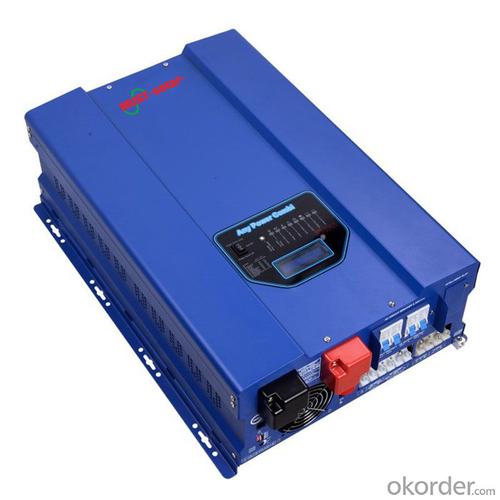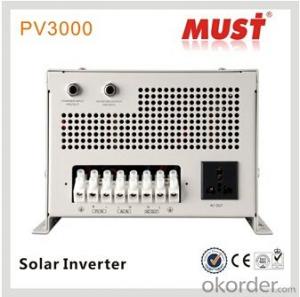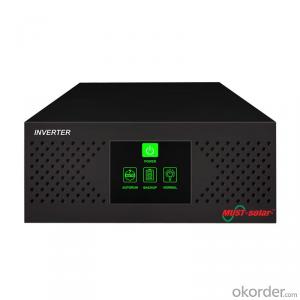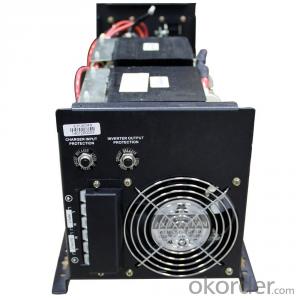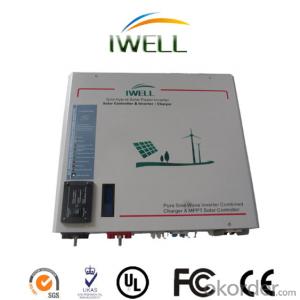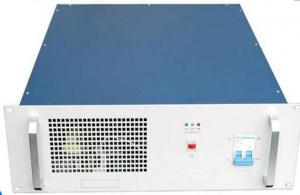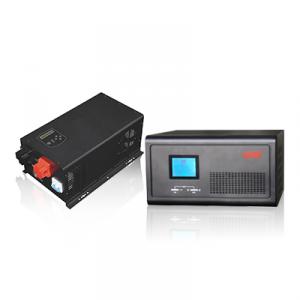Solar Inverter 1kva Pure Sine Wave Inverter Low Frequency EP3000 Series 8kw-12kw
- Loading Port:
- China main port
- Payment Terms:
- TT OR LC
- Min Order Qty:
- 10 pc
- Supply Capability:
- 1000 pc/month
OKorder Service Pledge
OKorder Financial Service
You Might Also Like
Features:
. Smart Remote Control (RMT)
. Battery Temperature Sensor (BTS)
. Automatic Generator Starting (AGS)
. Support Solar Panel with MPPT Function
. Designed to Operate under Harsh Environment
. DC Start & Automatic Self-Diagnostic Function
. Compatible with Both Linear & Non-Linear Load
. Easy to Install & Easy to Operate & Easy to Solve
| Model | 8.0KW | 10.0KW | 12.0KW | |
| Inverter Output | Continuous Output Power | 8.0KW | 10.0KW | 12.0KW |
| Surge Rating(20ms) | 24.0KW | 30.0KW | 36.0KW | |
| Output Waveform | Pure Sine wave/Same as input(Bypass Mode) | |||
| Nominal Efficiency | >88%(Peak) | |||
| Line Mode Efficiency | >95% | |||
| Power Factor | 0.9-1.0 | |||
| Nominal Output Voltage rms | 100-110-120Vac / 220-230-240Vac | |||
| Output Voltage Regulation | ±10% RMS | |||
| Output Frequency | 50Hz ± 0.3Hz/60Hz ± 0.3Hz | |||
| Short Circuit Protection | Yes( 1sec after fault ) | |||
| Typical transfer Time | 10ms(Max) | |||
| THD | < 10% | |||
| DC Input | Nominal Input Voltage | 12.0Vdc | ||
| ( *2 for 24Vdc, *4 for 48Vdc) | ||||
| Minimum Start Voltage | 10.0Vdc | |||
| Low Battery Alarm | 10.5Vdc / 11.0Vdc | |||
| Low Battery Trip | 10.0Vdc / 10.5Vdc | |||
| High Voltage Alarm | 16.0Vdc | |||
| Low Battery voltage recover | 15.5Vdc | |||
| Idle Consumption-Search Mode | < 25 W when Power Saver On | |||
| Charger | Output Voltage | Depends on battery type | ||
| Charger Breaker Rating | 40A | |||
| Max Charge Power Rate | 1/3 Rating Power | |||
| Battery Initial Voltage for Start Up | 10-15.7V for 12V( *2 for 24V, *4 for 48V) | |||
| Over Charge Protection Shutdown | 15.7V for 12V (*2 for 24V, *4 for 48V) | |||
| Remote Control | Yes(Optional) | |||
| Bypass & Protection | Input Voltage Waveform | Sine wave (Grid or Generator) | ||
| Nominal Voltage | 230Vac | |||
| Max Input AC Voltage | 150VAC For 120Vac LV Mode;300VAC For 230Vac HV Mode; | |||
| Nominal Input Frequency | 50Hz or 60Hz (Auto detect) | |||
| Low Freq Trip | 47±0.3Hz for 50Hz, 57±0.3Hz for 60Hz | |||
| High Freq Trip | 55±0.3Hz for 50Hz, 65±0.3Hz for 60Hz | |||
| Overload protection(SMPS load) | Circuit breaker | |||
| Output Short circuit protection | Circuit breaker | |||
| Bypass breaker rating | 50A | 63A | 63A | |
| Transfer switch rating | 80amp for UL | |||
| Bypass without battery connected | Yes (Optional) | |||
| Max bypass current | 80amp | |||
| Solar Charger (Optional) | Rated Voltage | 12Vdc / 24Vdc / 48Vdc | ||
| Solar Input Voltage Range | 15-30Vdc / 30-55Vdc / 55-100Vdc | |||
| Rated Charge Current | 40 ~ 60A | |||
| Rated Output Current | 15A | |||
| Self Consumption | < 10mA | |||
| Bulk Charge(Default) | *2 for 24Vdc, *4 for 48Vdc | |||
| Floating Charge(Default) | ||||
| Equalization Charge(Default) | ||||
| Over Charge Disconnection | ||||
| Over Charge Recovery | ||||
| Over Discharge Disconnection | ||||
| Over Discharge Reconnection | ||||
| Temperature Compensation | ||||
| Ambient Temperature | 0 ~ 40°C(Full load) 40 ~ 60°C(Derating) | |||
| Mechanical Specifications | Mounting | Wall Mount | ||
| Inverter Dimensions(L*W*H) | 588*415*200mm | |||
| Inverter Weight(Solar Chg)KG | 60+2.5 | 66+2.5 | 70+2.5 | |
| Shipping Dimensions(L*W*H) | 750*520*310mm | |||
| Shipping Weight(Solar Chg)KG | 62+2.5 | 68+2.5 | 72+2.5 | |
| Display | Status LEDs / Status LEDs+LCD | |||
| Standard Warranty | 1 Years (Optional) | |||
Warranty
provides a 1~3 year limited warranty (“Warranty”) against defects in materials and workmanship for its Uninterruptible power supply, Power inverter/chargers, Solar charge controllers, Battery Products (“Product”).
The term of this Warranty begins on the Product(s) initial purchase date, or the date of receipt of the Product(s) by the end user, whichever is later. This must be indicated on the invoice, bill of sale, and/or warranty registration card submitted to MUST-Solar. This Warranty applies to the original MUST-Solar Product purchaser, and is transferable only if the Product remains installed in the original use location.
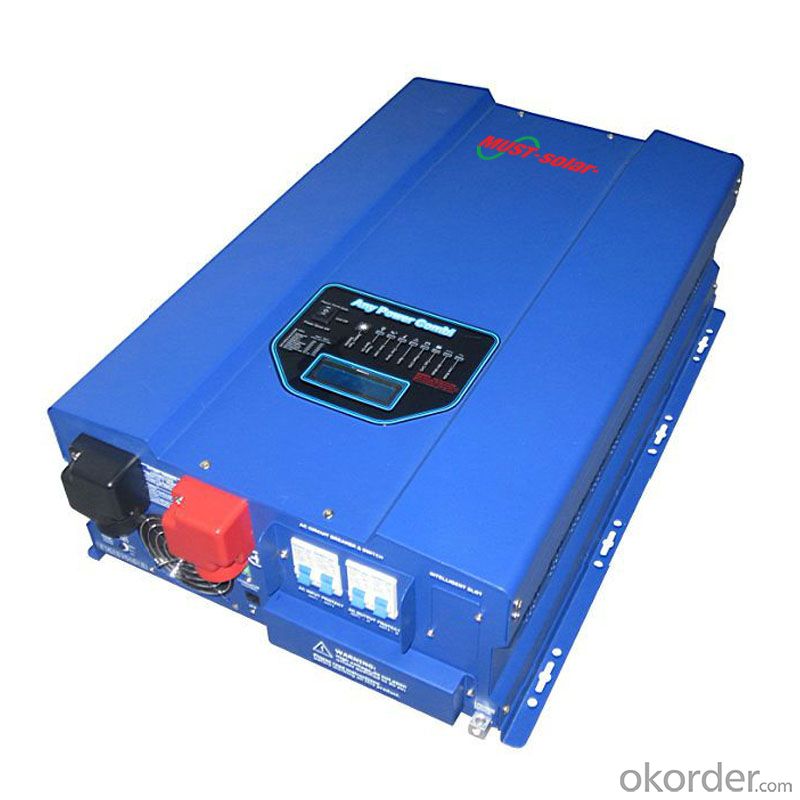
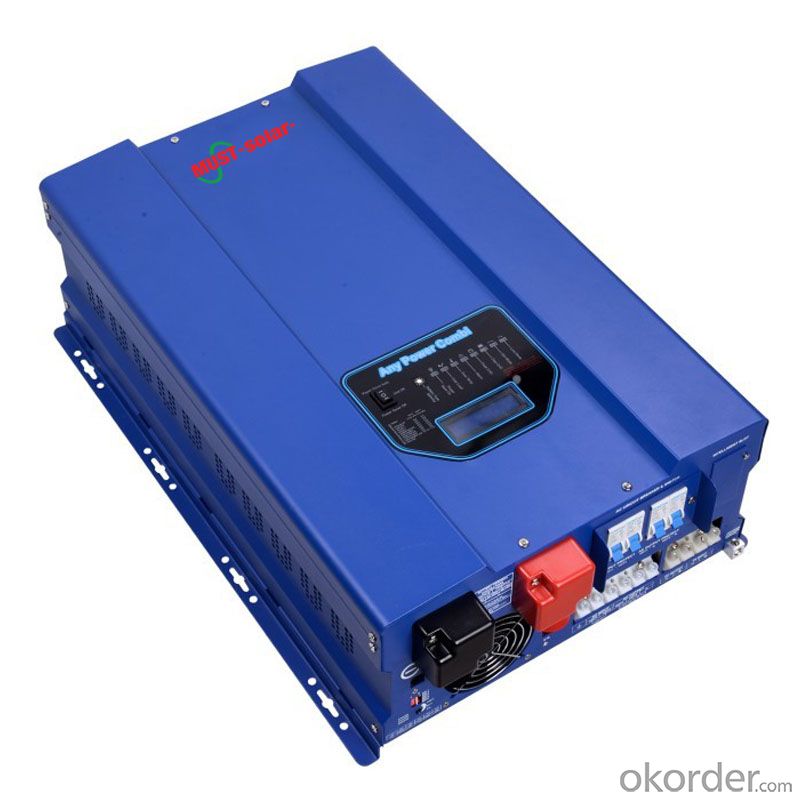
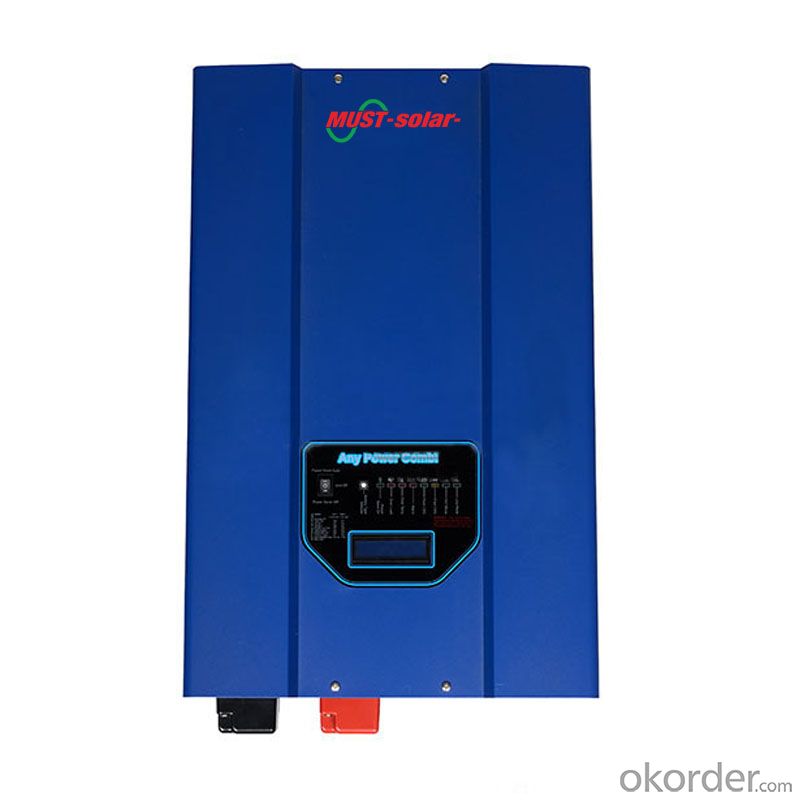
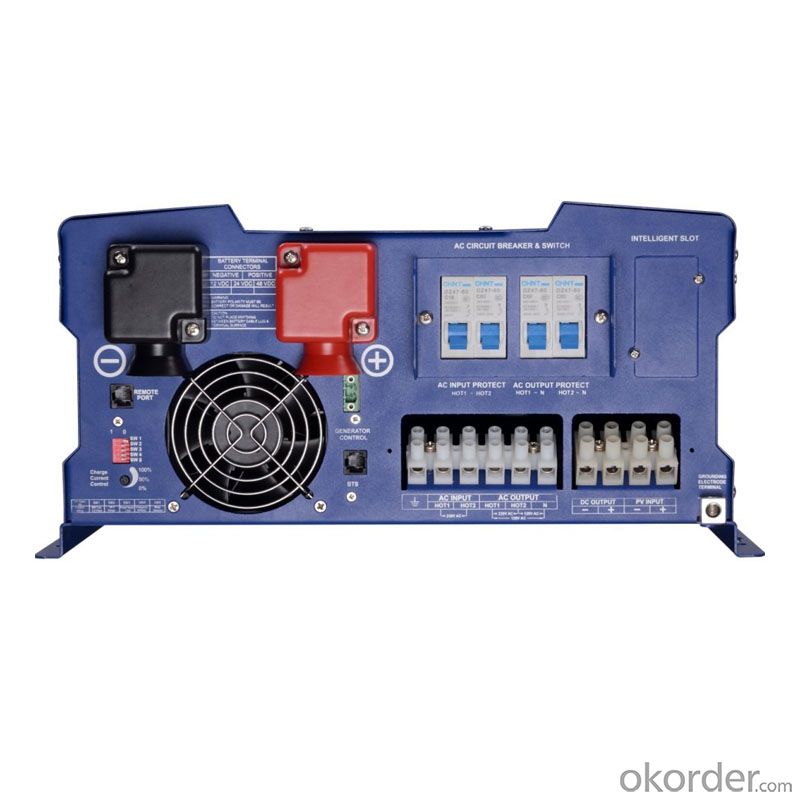
FAQ
1. How do I decide which system is right for me ?
For protection from long outages, include a generator or solar panels in your Must solar system. Shorter outages can be handled by a battery-only system.
2. Where my system will be installed ?
Must solar systems are usually wall-mounted near a home's main electrical (circuit breaker) panel.
3. How do I install my system ?
A must solar backup inverter is connected to a home electric system , we will supply detailed installation manual and videos for our customers .
- Q: What is the purpose of a solar inverter in a solar power system?
- The purpose of a solar inverter in a solar power system is to convert the direct current (DC) electricity generated by the solar panels into alternating current (AC) electricity that can be used to power household appliances or be fed back into the grid.
- Q: Can a solar inverter be used in areas with frequent power outages?
- Yes, a solar inverter can be used in areas with frequent power outages. Solar inverters are designed to convert the direct current (DC) generated by solar panels into alternating current (AC) that can be used to power household appliances and other electrical devices. In areas with frequent power outages, solar inverters with battery backup systems can store excess solar energy, which can be used during power outages to provide electricity. This helps to ensure a continuous power supply even when the grid power is unreliable.
- Q: How does a solar inverter handle variations in ambient temperature?
- A solar inverter is designed to handle variations in ambient temperature by incorporating temperature compensation algorithms. These algorithms adjust the inverter's performance parameters, such as voltage and frequency, based on temperature measurements. This ensures that the inverter operates optimally and efficiently across a wide range of temperature conditions, maintaining stable and reliable power conversion from the solar panels.
- Q: How is the efficiency of a solar inverter measured?
- The efficiency of a solar inverter is typically measured by dividing the output power of the inverter by the input power, and then multiplying the result by 100 to get a percentage value.
- Q: What is the operating temperature range of a solar inverter?
- The operating temperature range of a solar inverter typically varies between -20°C to 60°C (-4°F to 140°F).
- Q: Can a solar inverter be used in a solar-powered street lighting system?
- Yes, a solar inverter can be used in a solar-powered street lighting system. The solar inverter is responsible for converting the direct current (DC) power generated by the solar panels into alternating current (AC) power, which is required for the operation of street lights. Therefore, it plays a crucial role in ensuring the efficient and reliable functioning of a solar-powered street lighting system.
- Q: Can a solar inverter be monitored remotely?
- Yes, a solar inverter can be monitored remotely. With the advancement in technology, many solar inverters are equipped with monitoring systems that allow users to remotely monitor and control their solar power systems. This can be done through various methods such as mobile apps, web-based platforms, or even through specialized software. Remote monitoring enables users to track the performance, energy production, and overall health of their solar inverters from any location with internet access.
- Q: How does a solar inverter handle sudden changes in solar irradiation?
- A solar inverter handles sudden changes in solar irradiation by constantly monitoring the incoming solar energy and adjusting its output power accordingly. When there is a sudden increase in solar irradiation, the inverter increases its power output to match the higher energy generation. Similarly, when there is a sudden decrease in solar irradiation, the inverter reduces its power output to align with the lower energy production. This dynamic response ensures the inverter efficiently converts the available solar energy into usable electricity, regardless of variations in solar irradiation.
- Q: Can a solar inverter be used with solar-powered electric fences?
- Yes, a solar inverter can be used with solar-powered electric fences. Solar inverters are commonly used to convert the direct current (DC) energy generated by solar panels into alternating current (AC) energy, which is suitable for powering electric fences. By connecting the solar panels to a solar inverter, the generated solar energy can be efficiently utilized to power the electric fence system.
- Q: What are the key factors affecting the compatibility of a solar inverter with other system components?
- The key factors affecting the compatibility of a solar inverter with other system components include the voltage and frequency requirements, the type of PV modules used, the communication protocols supported, the maximum power output capacity, the efficiency and reliability of the inverter, and the overall system design and configuration.
Send your message to us
Solar Inverter 1kva Pure Sine Wave Inverter Low Frequency EP3000 Series 8kw-12kw
- Loading Port:
- China main port
- Payment Terms:
- TT OR LC
- Min Order Qty:
- 10 pc
- Supply Capability:
- 1000 pc/month
OKorder Service Pledge
OKorder Financial Service
Similar products
Hot products
Hot Searches
Related keywords




